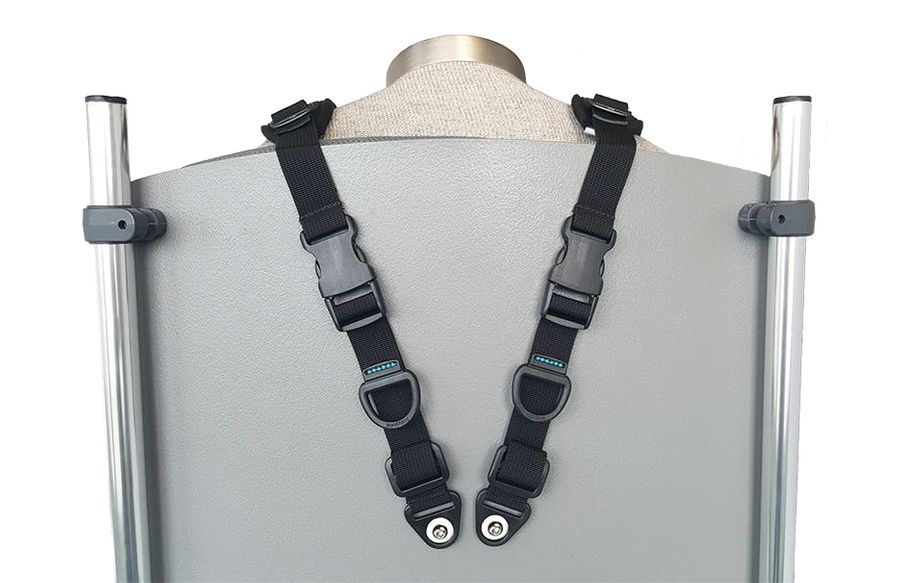Let’s Get it Clear: What makes a good positioning belt? 5. Harnesses and anterior support

In previous issues of THIIS in the Let’s Get it Clear series 1, we have covered ‘What makes a good cushion?’ over seven parts. An equally important component of many seating systems is the array of postural support devices (PSDs) provided with the seating to complement the cushion and back support elements. The first four parts of the current series concentrated on pelvic positioning belts, whereas this, the fifth in the series, looks at means to position the trunk with flexible anterior PSDs.
The previous articles in this series covered the anatomy of a pelvic positioning belt; choosing and adjusting a pelvic positioning belt; the features and benefits of different belt closures; and means to fix the belts to the wheelchair frame in appropriate positions. In this article we concentrate on anterior harnesses used to optimise the position of the trunk.
What do we mean by a harness?
For this series of articles we have been using the term ‘belt’ to represent a flexible postural support device (PSD), which has two main points of attachment to take the loads and stresses associated with helping to keep the wheelchair occupant in a required position – these ‘belts’ are most commonly used for positioning the pelvis.
Admittedly, some pelvic positioning belts have four points of attachment, but two of those straps are for positioning the person, while the other two are for positioning the belt (to stop it from getting out of position).

When we come to positioning the trunk, we often have a wider range of requirements of the flexible PSD. There are some places where a belt, e.g. a chest belt (Figure 1), is appropriate, but more often we are looking for greater surface areas to be covered, and more directions of control. In these cases we often look for a flexible PSD with symmetrically distributed four points of attachment, and refer to these as ‘harnesses’.
Chest vs shoulder harnesses
The selection of a harness needs to be based upon the ultimate aims for that harness. In some cases, as ‘shoulder harnesses’ they are there primarily used to provide shoulder retraction. Shoulder retraction assists respiratory and other physiological functions within the trunk, but too severe retraction can restrict the occupant’s reach and ‘zone of control’.
Many shoulder harnesses can be applied in differing manners both to accommodate the amount of retraction required and for comfort (e.g. to avoid pressure on breast tissue). For example, if the harness is used in ‘back pack’ conformation (without any of the harness across the chest), this provides the most retraction and least chest involvement. If applied in X style, one has the least retraction, and lesser breast interference.
H style provides a compromise on the degree of shoulder retraction but has the most breast interference. At least, for most shoulder harnesses, there is a choice.
Chest harnesses, on the other hand, while offering some shoulder control, primarily offer anterior support to the whole trunk, with the load spread over a larger area, but one does not have the choice of application offered by a shoulder harness. There are also specific safety risks involved with chest harnesses (see later).

Abdominal supports
Most of the postural supports covered in this series of articles have been designed to minimise impact on soft tissues, and have made use of applying forces across the bonier parts of the anatomy in order to make use of the leverage that can be obtained through these more solid parts to control or adjust the occupant’s posture.
There are places where the need to support soft tissues will come into play. These include across the abdomen, where an abdominal support comes into play. The benefits of these supports are:
- Support for sagging abdominal muscles
- Strengthening abdominal muscles and weakened abdominal walls
- Reducing pain while laughing
- Avoiding discomfort while coughing
- Avoiding squeezing or cramping up of muscles
- Assisting toning of abdominal muscles
Placement and adjustment of harnesses
Chest and shoulder harnesses should be positioned so that any central parts are no higher than the lower part of the sternum. The top straps should come across the shoulders horizontally, and if the top of the back support is not in a position to facilitate this, then extra mounting hardware will be required.
If the back support attachment is too high, this can lead to the straps rubbing on the neck, whereas if too low, this will pull the occupant down in the seat into a slouched posture. The mounting point of the upper straps onto the back support should be close together, thereby reducing the risk of the straps falling off the shoulders (Figure 3).
The lower straps should be positioned to maximise the postural control and comfort required for the occupant. Please be aware that if the back support is reclinable, the lower straps will need to be fastened to the lower part of the back support. Some recline in the back support to accommodate the shoulder blades is important – if the occupant is pushed too far forward, they risk being left ‘hanging’ on the harness.
Most harnesses are offered with front or rear pull adjustment options. The best choice often depends on the occupant’s preferences. Some people do not like their carer ‘fiddling’ around in front of them, so do not like the front pull option. Others do not like people behind them, so do not like the rear pull option. The front pull option gives the occupant the facility to tighten the straps themselves, whereas the rear pull option provides greater leverage for a carer tightening the straps.
Static vs dynamic?
The choice of a static rather than a dynamic harness depends on the needs of the occupant. A static harness provides a greater level of positioning and control, especially for those with low muscle tone. A harness with elasticated upper straps allows for a greater degree of movement, and helps the occupant back into position as their muscles fatigue over time during the day.
Elasticated lower straps allow for more freedom of minor adjustments of position, and accommodate the expansions and contractions associated with breathing.
Safety elements
The biggest safety concern is around minimising the risks to the occupant of strangulation and asphyxiation, and for this reason an anterior trunk harness should never be used without a properly positioned and fastened pelvic positioning belt in place.
Other concerns are around supporting, but not restricting the physiological functions ongoing within the torso, whether this be digestive, respiratory, cardiovascular, and bladder function – and effects on these internal functions being balanced with externally-oriented functional physical needs. We go into more depth around the safety considerations in Part 6 in this series, and this topic is covered in BS 8625 2.
References
- thiis.co.uk/lets-get-it-clear-addressing-mobility-and-posture-myths/
- BS 8625:2019 Selection, placement and fixation of flexible postural support devices in seating. Specification
Further items can be found at www.beshealthcare.net. If you are interested in receiving further information on the topic, please contact  barend@beshealthcare.net.
barend@beshealthcare.net.
Dr Barend ter Haar has been involved in seating and mobility for over 30 years, including lecturing internationally and developing international seating standards.
Click to read more from the ‘Let’s get it clear’ series from Dr Barend ter Haar


